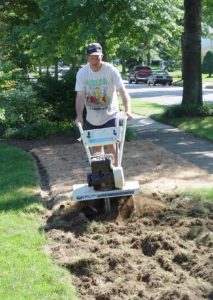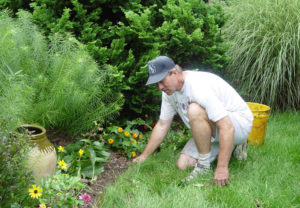Are You Suffering from These Gardening Diseases?
June 28th, 2022
Gardeners are prone to all sorts of medical and psychological afflictions not faced by the “normal” population.

This poor soul is suffering a bout of chlorophyllosis.
Maybe it’s the price we pay to conquer the many threats and curveballs involved in getting things to grow.
I thought I’d go over nine of these maladies that aren’t even well known in the medical community.
Chlorophyllosis
This is a gardener’s disease that usually strikes in May and involves an uncontrollable urge to dig out turfgrass and replace it with landscape plants. It tends to be chronic.
Symptoms include sudden bursts of adrenalin on weekends plus confusion and temporary loss of judgment at nurseries and garden centers. If uncontrolled, it can lead to bank overdrafts, and in severe cases, roof-top gardens.
Treatment: Chlorophyll cream and lavender aromatherapy. Otherwise, move to a new home with a large bare lot, and get a second job.
Furraphobia
This is an obsessive-compulsive disorder that involves an irrational fear of furry, four-legged, herbivores (especially deer, groundhogs, rabbits, and voles). Also common is a compulsion to examine plants for chewing damage every five minutes.
Other symptoms include anxiety, irritability, insomnia, and night sweats (sometimes day sweats, too, after chasing furry intruders out the yard).
Treatment: Anger-management therapy and possibly blood-pressure medication.

An attack of Cram Disease in progress.
Cram Disease
One of the most common gardening disorders, Cram Disease is recognized by an inability to understand and follow written planting instructions.
Symptoms include sore wrists from trowel overuse and garden beds packed so tightly with plants that even raindrops can’t get through.
Treatment: No cure is known, and relapses are common.
Cliptomania
Characterized by an uncontrollable urge to clip seed pods and tip cuttings from others’ plants, this psychological disorder gets worse with age and seems to strike females more than males.
Symptoms include green fingers and a swollen purse.
Treatment: Casts on both hands and avoidance of all cutting implements.
Turfiasis
This addiction is almost exclusively a male disorder and is marked by delusions and illusions of grandeur in the lawn.
Sufferers have been known to stare catatonically at turfgrass for hours on end, to talk into the ground, and to hoard large quantities of ureaform nitrogen and crabgrass preventer.
Treatment: Grass desensitization injections.

Rain often doesn’t even quell the symptoms of a hypermulchimia episode.
Hypermulchimia
Primarily a springtime disorder, this condition occasionally persists throughout summer and fall. It’s marked by bouts of bulk tanbark-buying that can add up to quantities large enough to cover the entire state of Delaware four inches deep.
Sufferers may hyperventilate or experience panic attacks when the driveway is devoid of a mulch pile. In winter, sufferers may be seen aimlessly wandering around pushing an empty wheelbarrow. In severe cases, patient may try to gnaw bark off pine trees.
Treatment: Bark-scented inhalers and adding pine nuts to the diet.
Hypomulchimia
Opposite of hypermulchimia, this sudden-onset disease strangely occurs only when sufferers hear their spouse utter the phrase, “Those flower beds need mulched!” The main symptoms are lethargy, sluggishness, sudden headaches, and sudden back pain.
Symptoms abate after dark, during the work week, and on bowling nights. This condition also is marked by the delusional belief that scattering a few handfuls of shredded bark here and there will actually prevent weeds from growing.
Treatment: A swift kick in the pants by the spouse’s right foot.
RADS
Rose Acquisition and Distraction Syndrome is another disease that for unknown reasons strikes males more than females.
Previously known as “roseum fanaticus,” RADS is an addictive disorder that results in unending trips to rose gardens and the overactive purchase of Miracle-Gro, fungicide sprays, fungicide dusts, and every insecticidal concoction known to mankind.
Sufferers also frequently report seeing black spots and may have recurring nightmares about Japanese beetles the size of rototillers.

A weeditis sufferer developing the tell-tale symptom of blistered hands.
Treatment: Psychological counseling and membership in Rosarians Anonymous.
Weeditis
This is an infectious disease that can quickly spread throughout an entire neighborhood. It starts when one or two people come down with chronic fits that involve trying to eradicate every last weed from their entire property. Soon, the fits spread to nearby neighbors and beyond.
If unchecked, the condition can lead to herbicidal addiction, low back pain, sore knees, and blistering of the hands.
Treatment: Tranquilizers.
May you avoid all of the above and have a happy, healthy 2022 gardening season.







